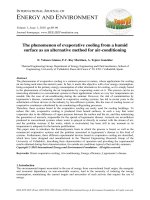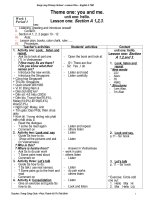The Internet As An Information Resource: Lesson 1: How the Internet Works
Bạn đang xem bản rút gọn của tài liệu. Xem và tải ngay bản đầy đủ của tài liệu tại đây (1.63 MB, 33 trang )
<span class='text_page_counter'>(1)</span><div class='page_container' data-page=1>
The Internet As An
Information Resource
</div>
<span class='text_page_counter'>(2)</span><div class='page_container' data-page=2>
<b>RATIONALE</b>
In conjunction with the shift from
print to digital information,
the Internet is fast becoming the
primary source of information,
requiring librarians and information
personnel to gain new skills and
</div>
<span class='text_page_counter'>(3)</span><div class='page_container' data-page=3>
<b>Learning outcomes</b>
By the end of the lesson, students
should be able to:
Define what is the Internet
Identify the major Internet tools and
services
Discuss briefly the Internet’s history
Understand basic Internet concepts,
terms and technology
</div>
<span class='text_page_counter'>(4)</span><div class='page_container' data-page=4>
<b>Scope</b>
What is the Internet?
What are the major Internet tools and
services?
What is the Internet’s history?
What are the basic Internet concepts,
terms and technologies?
</div>
<span class='text_page_counter'>(5)</span><div class='page_container' data-page=5>
<b>What is the Internet?</b>
The Internet is a global network of
</div>
<span class='text_page_counter'>(6)</span><div class='page_container' data-page=6>
<b>What is the Internet?</b>
The Internet covers large,
international Wide Area Networks
(WAN’s) as well as smaller Local
Area Networks (LAN’s) and
</div>
<span class='text_page_counter'>(7)</span><div class='page_container' data-page=7>
<b>What is the Internet?</b>
The Internet supports
</div>
<span class='text_page_counter'>(8)</span><div class='page_container' data-page=8>
<b>What are the major Internet </b>
<b>tools and services?</b>
Electronic mail (email)
Newsgroups
Internet Relay Chat (IRC)
Telnet
</div>
<span class='text_page_counter'>(9)</span><div class='page_container' data-page=9>
<b>E-mail</b>
The most popular use of the Internet
Available for free on the Web
• Yahoo Mail, Hotmail, Eudoramail
Valid e-mail address consists of a
username and a domain name
separated by the @ sign
• ex.
</div>
<span class='text_page_counter'>(10)</span><div class='page_container' data-page=10>
<b>Newsgroups</b>
Service dedicated to discussions on a
particular topic through posted
articles
Accessible through newsreaders
Names signify to users the topic of
discussion
• ex. alt.library.automation
</div>
<span class='text_page_counter'>(11)</span><div class='page_container' data-page=11>
<b>IRC (Internet Relay Chat)</b>
Allows real-time text based
communication through the
Internet
Organized by topic of interest into
“channels”
Discussion occurs in “chatrooms”
Some Websites have built-in
chatrooms
</div>
<span class='text_page_counter'>(12)</span><div class='page_container' data-page=12>
<b>Telnet</b>
Service that allows one computer to
access another computer
Enables the user to exchange data
and issue commands on the other
computer, the Telnet host
Mainly used by libraries to allow
access to information stored in their
computers
</div>
<span class='text_page_counter'>(13)</span><div class='page_container' data-page=13>
<b>FTP (File Transfer Protocol)</b>
Allows the transfer or copying of files from one
computer to another
Ideal for procuring or sending files to a remote
computer
FTP Programs available freely
Modern browsers have built in FTP capabilities
</div>
<span class='text_page_counter'>(14)</span><div class='page_container' data-page=14>
<b>World Wide Web (www)</b>
Invented in 1991 by Tim Berners-Lee, the web is
the fastest-growing Internet service.
Based on HTML (Hyper Text Markup Language)
allowing users to access data in multimedia
format
Simplest unit is the Webpage, primarily a
document encoded in HTML format that can be
accessed by using a browser
HTML links contents of a Webpage to each other
as well as to other Web pages through a
hyperlink
Each page has an address, a Uniform Resource
</div>
<span class='text_page_counter'>(15)</span><div class='page_container' data-page=15>
<b>What is the Internet’s history?</b>
The Internet grew from ARPANET the first
computer network designed for the Advanced
Research Projects Agency (ARPA) of the U.S
Department of Defense
ARPA sponsored research on interconnecting
geographically remote computers to allow
communication and sharing of data and resources
The goal was to create a communications
</div>
<span class='text_page_counter'>(16)</span><div class='page_container' data-page=16>
One of the early developments that proved
significant to the success of ARPANET (which
later on becomes the Internet) were “packet
switching” and “TCP/IP”
Packet switching involves digital systems that
transmit data in small packets that use the best
current path to their destination
TCP/IP is the core Internet protocol that allows
computers to communicate with each other
</div>
<span class='text_page_counter'>(17)</span><div class='page_container' data-page=17>
Realizing the value of interconnected
computers the academic community started
with its own research network
The NSFNet, created and named for the
National Science Foundation, linked academic
networks that connected universities and
research organizations around North America.
Networks from Europe and other countries
were connected to NSFNet making it the
backbone of the Internet.
</div>
<span class='text_page_counter'>(18)</span><div class='page_container' data-page=18>
ARPANET was decommissioned and the
management of the Internet was passed on to
the NSFNET
Restriction on commercial use was lifted
The emergence of World Wide Web, and Mosaic
brought an unprecedented growth to the Internet
NSFNET reverts back to a research project,
leaving the Internet in commercial hands and its
management to independent organizations
</div>
<span class='text_page_counter'>(19)</span><div class='page_container' data-page=19>
Summary
The Internet started as a military network called
ARPANET, which was involved in networking
research
The Internet later expanded to include
universities, businesses and individuals
Today, the Internet is also referred to as the Net,
Information Superhighway, and Cyberspace
</div>
<span class='text_page_counter'>(20)</span><div class='page_container' data-page=20>
<b>How does the Internet work?</b>
Protocols – standardized rules that define
how computers communicate and
exchange data
IP address – unique number used to
identify computers on the Internet
Domain name – structured naming system
to locate computers on the Internet
URL – uniform naming scheme that
specifies unique addresses of Internet
resources
</div>
<span class='text_page_counter'>(21)</span><div class='page_container' data-page=21>
<b>How does the Internet work?</b>
TCP/IP (Transmission Control Protocol
/ Internet Protocol)
The Internet is a packet-switching network
that uses TCP/IP as its core protocol
TCP/IP is a suite of protocols that govern
network addresses and the organization
and packaging of the information to be
sent over the Internet
</div>
<span class='text_page_counter'>(22)</span><div class='page_container' data-page=22>
<b>How does the Internet work?</b>
Internet Protocols
HTTP (Hypertext Transfer Protocol Protocol) - for
accessing and transmitting World Wide Web
documents
FTP (File Transfer Protocol Protocol) - for
transferring files from one computer to another
Gopher Protocol - for accessing documents via
Gopher menus (no longer widely used)
Telnet Protocol - allows users to logon to a
remote computer
</div>
<span class='text_page_counter'>(23)</span><div class='page_container' data-page=23>
<b>How does the Internet work?</b>
IP address
IP address is a unique address assigned to
each computer connected to the Internet
It is used by TCP/IP to route packets of
information from a sender to a location on
the Internet
IP address consist of four sets of numbers
</div>
<span class='text_page_counter'>(24)</span><div class='page_container' data-page=24>
<b>How does the Internet work?</b>
IP address
249.7.13.53
The first two number sets designate the
network
The third number set identifies the local
network
The fourth number set identifies the
</div>
<span class='text_page_counter'>(25)</span><div class='page_container' data-page=25>
<b>How does the Internet work?</b>
Domain names
Domain names are the alias or English
language equivalent of a computer’s IP
addresses
Domain Name System (DNS) allows the
use of easier to remember domain names
instead of IP addresses to locate
computers on the Internet
Domain Name Resolvers scattered across
</div>
<span class='text_page_counter'>(26)</span><div class='page_container' data-page=26>
<b>How does the Internet work?</b>
Domain names
Domain names have two parts:
• First part names the host computer
• Second part identifies the top level domain
Top level domains (TLD) – identifies the
type of host
• Generic Top Level Domains
• Country Code Top Level Domains
Domain names are used in URLs and
</div>
<span class='text_page_counter'>(27)</span><div class='page_container' data-page=27>
Top Level Domains
<b>.com – commercial/company site</b>
<b>.edu/ac - educational/academic </b>
<b>.gov – government site</b>
<b>.org – non-profit organization</b>
<b>.mil – military sites</b>
<b>.int – international organizations</b>
<b>.net – network providers</b>
</div>
<span class='text_page_counter'>(28)</span><div class='page_container' data-page=28>
Additional Top Level Domains
<b>.aero - restricted use by the air </b>
transportation industry
<b>.biz - general use by businesses </b>
<b>.coop - restricted use by cooperatives </b>
<b>.info - general use by both commercial </b>
and non-commercial sites
<b>.museum - restricted use by museums </b>
<b>.name - general use by individuals </b>
<b>.pro - restricted use by certified </b>
</div>
<span class='text_page_counter'>(29)</span><div class='page_container' data-page=29>
Country Code Top Level Domains
<b>.au – Australia .ph – Philippines</b>
<b>.cn – China</b> <b>.sg – Singapore</b>
<b>.fj – Fiji</b> <b>.uk – United Kingdom </b>
<b>.id – Indonesia.us – United States</b>
<b>.jp – Japan</b> <b>.tw - Taiwan</b>
<b>.mn – Mongolia .vn - Vietnam</b>
The complete list can be accessed at
/>
</div>
<span class='text_page_counter'>(30)</span><div class='page_container' data-page=30>
<b>How does the Internet work?</b>
Uniform Resource Locator (URL)
Each Internet document or file has a unique
address called a URL
The URL comprises of three parts:
• Protocol – lets the computer know how to
process the information it receives
• Domain name – Internet address of the
computer hosting the site and storing the
documents
</div>
<span class='text_page_counter'>(31)</span><div class='page_container' data-page=31>
<b>What is URL?</b>
<b> />
<b>Signifies that the site is part of the World Wide Web</b>
<b>Signifies that the site is part of the World Wide Web</b>
<b>Actual page</b>
<b>Actual page</b>
<b>The secondary </b>
<b>domain name</b>
<b>The secondary </b>
<b>domain name</b>
<b>Address of Internet server that uses the hypertext transfer protocol</b>
<b>Address of Internet server that uses the hypertext transfer protocol</b>
<b>The top level </b>
<b>domain signifying a </b>
<b>commercial site</b>
<b>The top level </b>
<b>domain signifying a </b>
<b>commercial site</b>
<b>File type</b>
<b>File type</b>
</div>
<span class='text_page_counter'>(32)</span><div class='page_container' data-page=32>
<b>"http“ </b>
• transfer protocol
<b>"www" </b>
• server name
<b>“amazon" </b>
• second-level domain name
<b>“com" </b>
• top-level domain name
<b>"books" </b>
• directory name
<b>“children" </b>
• file name
<b>"html" </b>
<b> />
</div>
<span class='text_page_counter'>(33)</span><div class='page_container' data-page=33>
<b>How does the Internet work?</b>
Client Server
The client server model is the distributed
computing architecture used by most Internet
services, generally classifying hosts on the
Internet as clients and servers
Client programs are used to access Internet
services provided by host computers running
server programs that provide the information or
service needed
For example web browsers are client programs
</div>
<!--links-->









